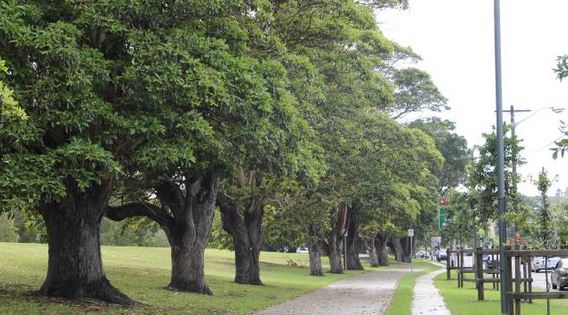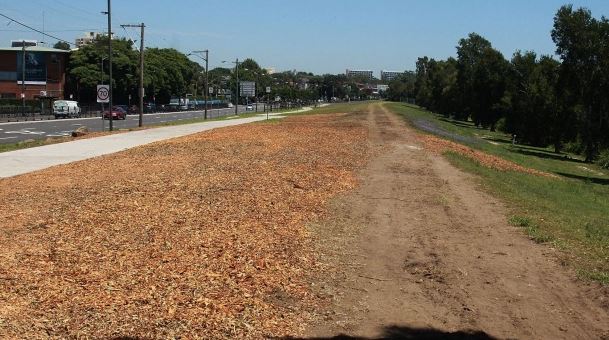 In just a few recent days, a line of historic and beautiful fig trees along Sydney’s Anzac Parade fell. No storm was involved. No act of God. This was man’s mechanical doing. And it all happened with the full, prior, knowledge and approval of NSW’s Baird government, which is building a new light-rail corridor from the city to Randwick and Kingsford. Future racegoers will roll to the track and students glide to the nearby University of NSW. But none of us will ever again enjoy the wonderful sylvan vista of mighty figs along Moore Park.
In just a few recent days, a line of historic and beautiful fig trees along Sydney’s Anzac Parade fell. No storm was involved. No act of God. This was man’s mechanical doing. And it all happened with the full, prior, knowledge and approval of NSW’s Baird government, which is building a new light-rail corridor from the city to Randwick and Kingsford. Future racegoers will roll to the track and students glide to the nearby University of NSW. But none of us will ever again enjoy the wonderful sylvan vista of mighty figs along Moore Park.
As Ogden Nash could have writ, I think I shall never see a light rail lovely as a tree. But then, the masters of light rail promise that so many more trees are to be planted instead. Nonetheless, I regret that the lovely, symmetric, shade-filled avenue that was Anzac Parade is now gone forever, the latest casualties of a philosophy and aesthetic that values ugly, multi-lane roads, steel forests of signage, and endless strips of tacky shops festooned with eyesore ads. Cheapskate developers, tasteless architects, and uncaring town planners conspire to see the urban jungle grow ever more distasteful to the eye.
And we do nothing about it.
Where, oh, where are all those inner city Green voters? (Admittedly, a few did chain themselves to Anzac Parade figs for a while, hugging trees on death row.) But 99% of the time, Greenies who say they care deeply about our environment seem to achieve little to preserve good urban environment.
It’s all very well to go on about the Tarkine or the Daintree or even the mighty Snowy, but these far flung corners of our country are not where average Australians spend much time, let alone reside. In the century since agriculture mechanised, and forest industries were all but shut, most Australians have ended up staring at each other — and the ugly face of urbanity — from suburban windows.
Australia’s cities urgently need work done – and not just with a mop, a bucket and a lick of paint. Most of our urban spaces need serious re-thinking, to improve their utility, safety and beauty. Inspired urban development can be wonderful: Avenues of trees, unspoiled by wires overhead. Buildings that match, amuse and appeal. A minimum of poles, signage and visual distraction. It works. We have all been places where, suddenly, it is clear we are in a pleasant, urban environment. The pulse quickens, the spirits lift, and the happiness of living visits our heart for a moment or two.
Rome wasn’t built in a day, and big, urban makeover projects take time. But instead, too often the overseers of our cities and suburbs seem to approve, or at least turn a blind eye, to yet more urban uglification. Each new blight that gets put up will one day have to come down.
Perhaps they just don’t see it. Perhaps, after years of trying to juggle society’s competing priorities — more roads, more residences, more commerce, more recreation — many planners have thrown up their hands in despair, capitulated to ugliness and accepted it as an unfortunate necessity.
Future generations will likely judge us harshly for the growing urban blight we will leave behind: Rough concrete, dirty and littered tarmac, cluttered signposts, lamp poles, high and intimidating walls and rusting steel fences, stained brickwork, poorly-executed murals or masses of crude, moronic and threatening graffiti. Surely we can do better!
Local councils are merging across Sydney this year – another grand project of the tree-felling, Baird government. Wouldn’t it be great if each new officer, alderman and mayor pledged to work towards making Sydney what it claims to be, one of the most beautiful urban environments in the world? Yes, it would take ideas, enthusiasm, and investment. But, yes, all that would be most worthwhile.
Here are a few ideas:
- Ask Sydneysiders (and visitors) which aspects of urban blight upset them most. Let them nominate the eyesores, plus suggestions for fixing them. (The power of 10,000 minds connected via the Internet can beat the power of one bored council employee at a desk.)
- Get local businesses and their customers to discuss how commercial and retail areas might transform themselves in order to delight and attract. Businesses that struggle to succeed amongst urban ugliness have much to gain from a makeover.
- Highlight where we have the urban environment right as examples to be followed. Which local shopping centres work well? Where are our most admired urban roads and vistas? What urban design has produced practical, beautiful results?
- Insist that any development, whether a second-storey on a suburban house or a new tower block of apartments, add to the visual amenity of its surroundings. No more tick-box lists for council approval, regardless of the ugly, inappropriate nature of the proposed construction.
- Tear down the ugliest examples of urban development. Not all at once, but over the course of, say, the next ten years, with incentives to make their replacements worthy of admiration. We can create a beautiful, functional, safe and economically responsible urban environment. But we need to make the effort.
Or do we hide collectively behind the lace curtains of our front window, fearing that nothing can be done, and turning on the TV yet again, to watch a documentary on the rainforest?
 Sign In
Sign In 0 Items (
0 Items ( Search
Search











With a bit of foresight many decades ago Sydney could have had both the light rail AND the beautiful trees. But, no, the tram tracks were smothered in tar and mothballed a long time ago. Look at Vienna’s beautiful Ring, circling the Innere Stadt; it has old, gracious trees, parkland and buildings and (arguably) the world’s most efficient public transport system of trams and buses. I’m still staggered by the fact that Sydney, with a population of nearing 5 million and sprawled out beyond tens of kilometers, has not invested in decent transport infrastructure before now. Don’t blame Baird for the felling of the trees; blame previous governments going back to the 1960s.
Good grief. Just move to the country for goodness sake.
My hundred acres is beautiful and will remain so unless some Greenie becomes involved. As pgang says “move to the country”. Are all those city jobs unable to be done elsewhere? With modern communication I can bank anywhere, shop anywhere and converse with anyone from a fixed wireless internet/phone 250 km from that amorphous grey mass called Sydney.
Just to pick a nit, it was Joyce Kilmer, not Ogden Nash, who might have written the words about never seeing light rail as lovely as a tree. As for the figs, unless I’m very mistaken they are far too young to have been ‘historic’, lovely as they undoubtedly were. I’m old enough to remember Anzac Parade as it was when the trams ran down that route, but that was then and this is now, and as Jody says, the necessary foresight didn’t exist back then, so fixing or alleviating the public transport that modern governments inherited from their more ignorant predecessors means compromises must be made. Sydney is Sydney, not some compact little European-style city with very high population densities, so Elizabeth Farrelly-esque fantasies about what might have been or could or should be in some dream of the future are economically impracticable, all things considered. No matter what option were to be chosen, some people would object. New trees will be planted.